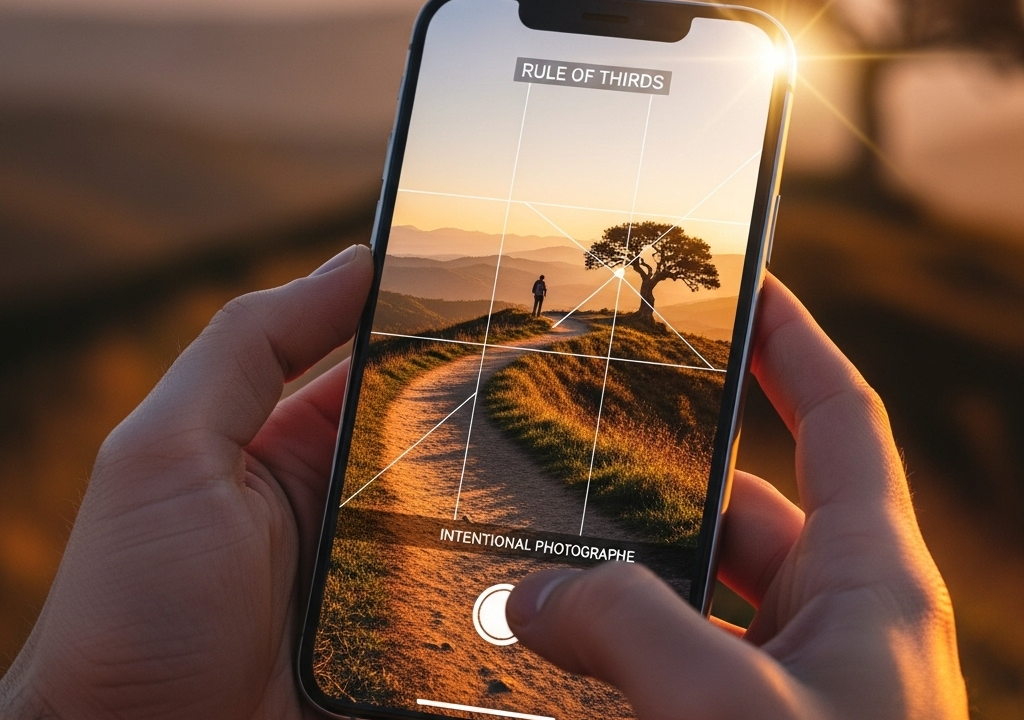How to Take Better Smartphone Photos: Mastering Composition & Lighting (Expert Tips)

In an age where our smartphones are almost always within reach, capturing life’s moments has never been easier. However, moving beyond simple snapshots to truly impressive images requires understanding a few core principles. This article, part of our Smartphone Photography series, aims to equip you with expert tips on composition and lighting, fundamentally helping you to improve phone camera photos and elevate your mobile photography skills. By mastering these fundamental photography basics, you’ll discover how to take better smartphone photos that stand out.
Mastering Smartphone Composition Rules
Good composition is the backbone of any compelling photograph, guiding the viewer’s eye and creating visual harmony. These smartphone composition rules are surprisingly easy to apply.
Utilize the Rule of Thirds Smartphone Camera
The rule of thirds smartphone camera setting is one of the most powerful tools at your disposal.
- Enable Your Grid: Most smartphones offer a grid overlay feature in their camera settings. Turn this on to divide your screen into nine equal sections with two horizontal and two vertical lines.
- Position Your Subject: Instead of centering your main subject, place it along these lines or at their intersections. This creates a more dynamic and engaging image. For instance, in a landscape, align the horizon with one of the horizontal lines.
Harness Leading Lines
Leading lines naturally draw the viewer’s gaze through your photograph, adding depth and direction.
- Identify Lines: Look for natural or man-made lines in your environment like roads, fences, rivers, or architectural elements.
- Guide the Eye: Position these lines to lead towards your main subject or through the scene, often working best when they run diagonally.
Embrace Symmetry and Patterns
Symmetry provides a sense of balance and order, while patterns add visual rhythm and interest.
- Seek Reflection: Bodies of water, reflective surfaces, or architectural designs often present opportunities for perfect symmetry.
- Spot Repetition: Look for recurring shapes, colors, or textures that create a compelling pattern.
The Power of Negative Space
Negative space, or the empty area around your main subject, is crucial for emphasizing it and creating a sense of simplicity.
- Simplify Your Background: Isolate your subject against a plain or uncluttered background to make it pop.
- Create Focus: Use expansive skies, clear walls, or calm water to allow your subject to breathe and become the undisputed focal point.
Changing Your Perspective
Don’t settle for eye-level shots. Experimentation with perspective can yield unique and captivating results.
- Go Low or High: Try shooting from a low angle, almost touching the ground, or from a higher vantage point to see how the scene transforms.
- Move Around: Walk around your subject to find the most interesting viewpoint, considering how the background changes with each shift.
Mind the Background and Foreground
What’s behind and in front of your subject is just as important as the subject itself.
- Declutter Backgrounds: Ensure your background enhances, rather than distracts from, your subject. If it’s too busy, reposition yourself or your subject.
- Add Foreground Interest: Including elements in the foreground can add depth, context, and a sense of scale to your image, especially in landscapes.
Illuminating Your Shots: Best Lighting for Phone Photos
Lighting is arguably the most critical element in photography, dictating mood, detail, and overall quality. Understanding the best lighting for phone photos can drastically improve your outcomes.
Embrace Natural Light and Golden Hour
Natural light is almost always superior for smartphone cameras, given their smaller sensors.
- Shoot Outdoors: Whenever possible, photograph your subjects outdoors where natural light is abundant.
- Leverage Golden Hour Phone Photography: The period just after sunrise and before sunset, known as “golden hour,” offers incredibly soft, warm, and flattering light that adds a beautiful glow to your subjects.
Avoid Harsh Sunlight Smartphone
Direct, overhead sunlight can create unflattering shadows and blown-out highlights, which smartphone cameras often struggle with.
- Seek Shade: If shooting midday, guide your subject into a shaded area. This diffuses the light, making it softer and more even.
- Backlight Creatively: Sometimes, positioning your subject with the sun behind them can create a beautiful silhouette or a glowing halo effect, but be mindful of exposure.
Indoor Lighting Strategies
Indoor lighting can be tricky, but strategic use of available light can make a difference.
- Maximize Windows: Open curtains and blinds to let in as much natural window light as possible.
- Turn Off Artificial Lights: Avoid mixing natural light with harsh indoor artificial lights, which can create color inconsistencies and unwanted shadows.
When to Use HDR
High Dynamic Range (HDR) mode helps balance exposure in high-contrast scenes.
- High Contrast Scenes: Enable HDR for landscapes with bright skies and dark foregrounds, or backlit subjects. This feature captures multiple exposures and combines them to bring out detail in both the brightest and darkest areas.
Low Light Solutions
Smartphones can struggle in low light, but there are techniques to manage it.
- Utilize Existing Light Sources: Look for ambient artificial lights like streetlights, neon signs, or even car headlights to illuminate your subject.
- Stabilize Your Phone: In low light, the camera’s shutter stays open longer, making it prone to blur. Use both hands, lean against a stable surface, or invest in a small tripod to keep your phone steady.
- Adjust Exposure Manually: Most phone cameras allow you to tap on the screen to focus and then slide a sun icon to manually brighten or darken the exposure, which is invaluable in challenging lighting conditions.
General Smartphone Photography Tips for Photo Improvement
Beyond composition and lighting, a few general mobile camera tips can significantly contribute to overall photo improvement.
Essential Practices
- Clean Your Lens: A smudged lens is a common culprit for blurry or hazy photos. Always give your phone’s camera lens a quick wipe with a soft cloth before shooting.
- Avoid Digital Zoom: Digital zoom simply crops and enlarges pixels, degrading image quality. Instead, physically move closer to your subject to maintain sharpness and detail.
- Take Multiple Shots: Don’t be shy about taking several photos of the same scene or subject from slightly different angles or with minor adjustments. This increases your chances of capturing the perfect shot, especially with moving subjects.
- Learn Your Camera App: Explore your smartphone camera’s features beyond the basic shutter button. Many phones offer “Pro” or “Manual” modes that give you control over ISO, shutter speed, and white balance, providing more creative freedom.
By consciously applying these smartphone photography tips, focusing on strong smartphone composition rules and understanding the best lighting for phone photos, you’ll consistently improve phone camera photos. Practice is key; the more you experiment with these techniques, the more intuitive they will become, allowing you to capture stunning images with just the device in your pocket.
